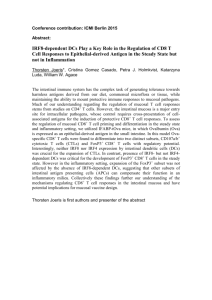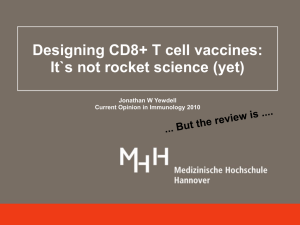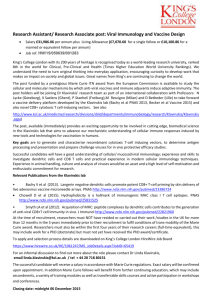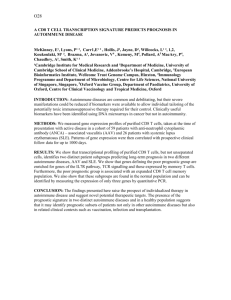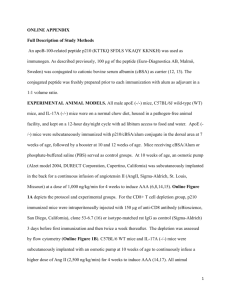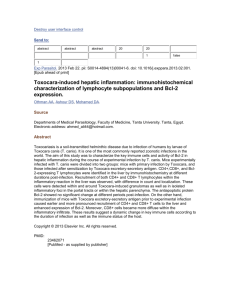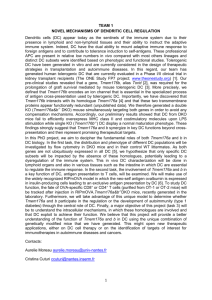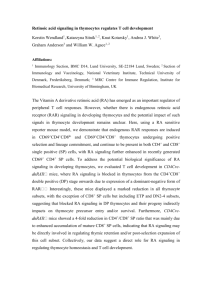Chapter 22: Non-apoptotic HIV Induced T-cell Death
advertisement
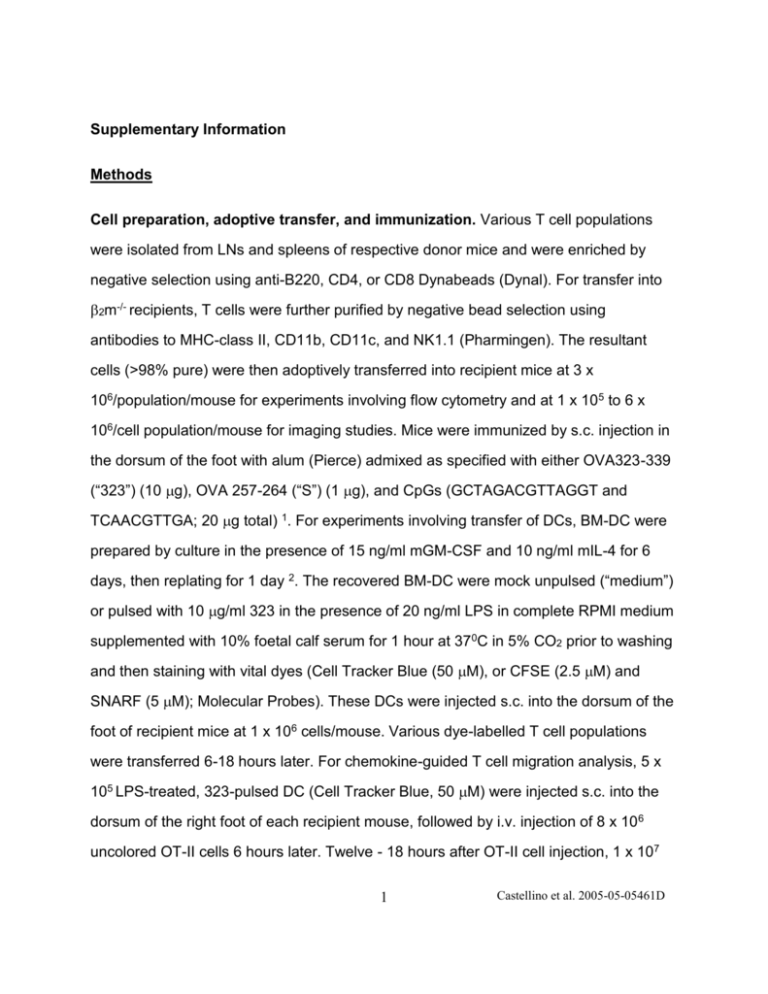
Supplementary Information
Methods
Cell preparation, adoptive transfer, and immunization. Various T cell populations
were isolated from LNs and spleens of respective donor mice and were enriched by
negative selection using anti-B220, CD4, or CD8 Dynabeads (Dynal). For transfer into
2m-/- recipients, T cells were further purified by negative bead selection using
antibodies to MHC-class II, CD11b, CD11c, and NK1.1 (Pharmingen). The resultant
cells (>98% pure) were then adoptively transferred into recipient mice at 3 x
106/population/mouse for experiments involving flow cytometry and at 1 x 10 5 to 6 x
106/cell population/mouse for imaging studies. Mice were immunized by s.c. injection in
the dorsum of the foot with alum (Pierce) admixed as specified with either OVA323-339
(“323”) (10 g), OVA 257-264 (“S”) (1 g), and CpGs (GCTAGACGTTAGGT and
TCAACGTTGA; 20 g total) 1. For experiments involving transfer of DCs, BM-DC were
prepared by culture in the presence of 15 ng/ml mGM-CSF and 10 ng/ml mIL-4 for 6
days, then replating for 1 day 2. The recovered BM-DC were mock unpulsed (“medium”)
or pulsed with 10 g/ml 323 in the presence of 20 ng/ml LPS in complete RPMI medium
supplemented with 10% foetal calf serum for 1 hour at 370C in 5% CO2 prior to washing
and then staining with vital dyes (Cell Tracker Blue (50 M), or CFSE (2.5 M) and
SNARF (5 M); Molecular Probes). These DCs were injected s.c. into the dorsum of the
foot of recipient mice at 1 x 106 cells/mouse. Various dye-labelled T cell populations
were transferred 6-18 hours later. For chemokine-guided T cell migration analysis, 5 x
105 LPS-treated, 323-pulsed DC (Cell Tracker Blue, 50 M) were injected s.c. into the
dorsum of the right foot of each recipient mouse, followed by i.v. injection of 8 x 10 6
uncolored OT-II cells 6 hours later. Twelve - 18 hours after OT-II cell injection, 1 x 107
1
Castellino et al. 2005-05-05461D
each of freshly isolated WT polyclonal CD8+ T cells labelled with SNARF (5 M) and
CCR5-/- polyclonal CD8+ T cells labelled with CFSE (2.5 M) were co-injected i.v. for
intravital 2-photon imaging beginning at 6 hours later. For analysis involving in vivo
chemokine neutralization, various chemokine blocking antibodies or isotype matched
controls (R&D; anti-CCL4, MAB 451 and AF451; anti-CCL3, MAB450 and AF450; antiCCL19,MAB880; anti-CXCL12, MAB310, or matched isotype controls MAB006, AB108,
and MAB002) were injected i.v. (50 g in PBS/mouse) at the time of immunization.
Flow cytometry. T cells (3 x 106 cells/population) were injected i.v. into Ly5.2 congenic
mice. Twenty-four hours later recipient mice were immunized s.c. in the dorsal regions
of both feet with different vaccine formulations. Forty hours after immunization the
draining popliteal LNs were treated with collagenase (3.5 mg/ml Sigma) + DNAse (200
ng/ml; Sigma) and the distribution and phenotype of CD8+ T cells analyzed by flow
cytometry. All antibodies used for flow cytometry were purchased from Pharmingen with
the exception of the CD45.2 Ig (e-bioscience). OT-I or total CD8+ T cell content was
expressed as a percentage of the total LN cell content. Data are expressed as the ratio
of CD8+ T cell content (%) in the LN draining a vaccine formulation containing 323 to the
CD8+ T cell content (%) in the contralateral LN draining a vaccine formulation without
323. Similar results were obtained when absolute numbers of CD8 + T cells, rather than
percentages, were used to derive this ratio (FC, unpublished observations).
Chemokine secretion assays and intracellular staining. For detection of chemokine
production by vaccine draining lymph nodes, mice were adoptively transferred with
3x106 OT-II T cells 24 hours prior to s.c. injection of the indicated vaccine formulations.
Thirty hours later the draining LN was removed and incubated either in complete
medium for 12 hours followed by quantitative chemokine measurement of the LN
2
Castellino et al. 2005-05-05461D
supernatants by ELISA (R&D Systems), or in complete medium containing Brefeldin A
(BFA) for 4 hours, followed by cell dispersal for intracellular chemokine staining and
analysis by flow cytometry. For experiments involving detection of CCL3/CCL4
heterodimers, mice adoptively transferred with 3x106 OT-II T cells 24 hours earlier were
immunized with alum+CpG+323 in the dorsum of the foot. Thirty hours later the draining
LN was removed and incubated in complete medium for 12 hours. The supernatants
were harvested and incubated for 2 hours with different plate-bound antibodies, and the
pre-absorbed supernatants were then assayed for chemokine content by ELISA. In
other experiments, BM-DC (1 x 106/ml) or OT-II CD4+ T cells (0.5 x 106/ml) were
cultured overnight under the indicated conditions to induce production of CCL3 and
CCL4. Where indicated, agonistic anti-CD40 antibody (clone 1C10, R&D Systems) was
added at 1 g/ml. Chemokines were measured in the supernatants by ELISA.
Quantitation of chemokine transcripts in lymph nodes. For detection of chemokine
mRNA in draining lymph nodes, mice were adoptively transferred with 5x10 6 OT-II T
cells 24 hours prior to s.c. injection of the indicated vaccine formulations. Alternatively,
mice were first injected s.c. with peptide-pulsed DCs 12 hours prior to adoptive transfer
of OT-II T cells. Thirty-six hours later the draining LNs were harvested and lysed in
TRIzol Reagent (Invitrogen) and total RNA was isolated using RNeasy Mini Kit
(QIAGEN) following the manufacturer’s instructions. One microgram of total RNA was
reverse-transcribed to cDNA using SuperScript III First-Strand Synthesis System for
RT-PCR (Invitrogen). Quantitative PCR was performed on a 7900HT sequence
detection system (Applied Biosystems). The primer and probe sets for detecting murine
CCL3 and CCL4 (FAM-MGB probe), and TaqMan Ribosomal RNA control reagents for
detecting the 18S ribosomal RNA (VIC-MGB probe) were purchased from Applied
3
Castellino et al. 2005-05-05461D
Biosystems. The levels of mRNA for the cytokines were normalized to that of 18S
ribosomal RNA.
Intravital two-photon imaging. Six to 30 hours after fluorescent-labelled T cell
transfer, recipient mice were anesthetized i.p. with 0.25 mg/gm body weight of Avertin
(2,2,2-Tribromoethanol; Sigma) and intravital microscopy was performed on the right
popliteal LN using a modified surgical technique previously described 3. The mouse and
exposed LN were kept at 37oC within a fixed enclosure using both an environmental
heater and a thermal blanket. 2-photon microscopy was conducted using a Bio-Rad /
Zeiss Radiance 2100MP system equipped with a Nikon 600FN upright microscope, 20X
water immersion lens (N.A. 0.95, Olympus), and either a Mira 900 Sa:Ti femtosecond
pulsed laser tuned to 783-800 nm driven by a 10-watt Verdi pump laser (Coherent) or a
Chameleon laser (Coherent) with similar specifications. Images were collected with
typical voxel size = 0.91 m 0.91 m 3-5 m and a volume dimension = 467 m
467 m 50-100 m, unless otherwise noted. This volume collection was repeated
every 15-40 seconds for up to 45 minutes to create a 4-D data set. The resultant image
data were processed using Imaris software (Bitplane) to create sequential 2-D
maximum intensity projections. Movies were then generated from these imaging data
using Adobe After Effects (Adobe). The rate enhancements of these movies relative to
real time are indicated in the legends.
Hit rate analysis. The number of individual new contacts formed during the imaging
session between a labelled DC and labelled CD8+ T cells in the same LN were
quantitated by individual inspection of each time slice at each z-slice level in the 4D
imaging data set. A DC-CD8+ T cell hit rate was then calculated using the equation,
Kon= A / [T Cells] [DC]• t, where Kon is the calculated hit rate (mm6. hr-1), A is the total
4
Castellino et al. 2005-05-05461D
observed number of DC-T cell contacts, [T cells] and [DC] are densities of T cells and
DC in a data collection volume (typically 467 m x 467 m x 50 m), and t represents
the duration of imaging session. Hit rate ratio was determined as the ratio between the
Kon for CD8+ T cells interacting with 323-pulsed DCs and the Kon for interactions
involving unpulsed DCs within the same imaged LN region.
Chemotaxis / chemokinesis analysis. Individual image sequences from intravital 2photon microscopy were processed using Imaris tracking software (Bitplane), and the
positions of individual T cells {Tn} and DCs {Dn} were measured as a function to time
{tn}. We first measured the closest distance (CD) of approach to an isolated DC made
by a particular T cell during an imaging session and then determined the furthest point
from which the same T cell began its approach towards the same DC during the same
imaging session. The instantaneous speed (vn) was computed as v n Tn Tn 1
t n 1 t n .
Distributions of the instantaneous speed were calculated for WT and CCR5 -/- CD8+ T
cells that achieved a CD =< 25 m. Based on the distribution
of these instantaneous
speeds (Fig. 4c), a gate was set at v = 10 m/min to distinguish fast from slow steps
among individual steps along T cell trajectories (S Fig. 5). For these two types of
migration steps, we determined the distribution of the angular approach { n} towards the
DCs as: n ASin - Tn Tn +1.Dn Tn
T T
n
n +1
. Dn Tn
. An angle of +90º reflects a move
towards the DC, whereas an angle of -90o represents a move away from the DC. For
these analyses, only T cells approaching DC were included in the calculation; T cells
leaving the imaging fields or visibly contacting DC at the beginning of the tracking
experiments were excluded from analysis. A total of 518 CCR5-/- CD8+ T cells and 553
WT CD8+ T cells in 6 independent 30-minute imaging sequences from 4 independent
experiments were tracked for these analyses.
5
Castellino et al. 2005-05-05461D
Effect of CCL3/4 blocking on CD8+ T cell functional responses. OT-I cells stained
with 2.5 M CFSE (Molecular Probes) and OT-II cells were co-transferred i.v. into
congenic recipients (3 x 106 purified T cells of the indicated type per recipient). One day
later the mice were immunized s.c. with alum admixed with OVA 257-264 (1 g) and
CpGs (20 g) in the presence or absence of 323 (10 g) and in the presence or
absence of neutralizing antibodies to CCL3 and CCL4 or isotype-matched control
antibodies (50 g in PBS/mouse). The mice were sacrificed at different times after
immunization, perfused with PBS-heparin, and LN, spleen, liver, and lungs collected.
The different organs were treated with collagenase and DNAse (Calbiochem) before cell
isolation and staining for flow cytometry. OT-I cells were identified by staining with
CD45.2 and CD8. For the analysis of IFN-responses to antigen, the isolated cells were
restimulated for four hours with SIINFEKL peptide (10 ng/ml) in the presence BFA,
stained for surface markers, permeabilized using the Cytofix/Cytoperm Plus kit
according to the manufacturer’s instructions (PharMingen), then stained for cytokine
content and analyzed by flow cytometry.
Supplementary Figure Legend
Supplementary Figure 1
a. In vivo secretion of CCL3 and CCL4 in vaccine-draining lymph nodes.
Mice were immunized with indicated vaccine mixtures following adoptive transfer of OTII T cells. Thirty hours later the draining LNs were removed and bathed in complete
medium for 12 hours. The supernatants were then harvested and CCL3 (gray) and
6
Castellino et al. 2005-05-05461D
CCL4 (black) quantitated by ELISA. The average and standard error for data from three
independent experiments are shown.
b. Measurement of CCL3 and CCL4 transcripts in lymph nodes.
Mice were immunized either with CpG-containing vaccine mixtures following adoptive
transfer of OT-II T cells, or with BM-DC pulsed with or without 323 12 hours prior to
adoptive transfer of OT-II T cells. Thirty-six hours later the draining LNs were removed
and total RNA immediately extracted. Quantitative RT-PCR using probes specific for
CCL3 (gray) and CCL4 (black) was performed and the results were compared to levels
of 18S ribosomal RNA. The average and standard error for data from 2 independent
experiments are shown.
c. In vitro production of CCL3 and CCL4 by activated DCs and T cells.
Supernatants from cultures of BM-DCs or OT-II T cells were analyzed for CCL3 (gray)
and CCL4 (black). Day 6 BM-DC were either not replated (resting) or replated and
cultured for an additional 2 days. When indicated, DCs were cultured for the final 18
hours in the presence of agonistic CD40-Ig (1 g/ml), LPS (5 ng/ml), or both.
Alternatively, naïve OT-II were cultured overnight in the absence or presence of plate
bound anti-CD3 (5 g/ml) and soluble anti-CD28 (10 g/ml). The average of three
independent experiments is shown.
d-e. Intracellular staining of CCL3 and CCL4 in DCs and CD4+ T cells from
draining LNs.
Congenic mice were immunized following adoptive transfer of OT-II T cells. Thirty hours
later the draining LNs were removed and bathed in complete medium containing BFA
7
Castellino et al. 2005-05-05461D
for 4 hours before collagenase treatment and intracellular staining of the dispersed cells
with CCL3 (left panel) and CCL4 (right panels) antibodies. d. Mice were immunized
with alum+CpG (dotted line) or alum+CpG+323 (thick line), and CD11c+ cells in the DLN
were stained for intracellular chemokine content. e. Mice were immunized with either
alum+CpG (dotted line) or alum+CpG+323 (thick line), and the intracellular content of
chemokines in OT-II T cells from the draining LNs were compared. Endogenous CD4+ T
cells from all draining LNs showed the same staining pattern as OT-II T cells from LNs
draining alum+CpG immunization (data not shown). Shaded gray = isotype control.
f. Detection of CCL3 and CCL4 heterodimers
Mice were immunized with alum+CpG+323 following adoptive transfer of OT-II T cells.
Thirty hours later the draining LNs were removed and incubated in complete medium for
12 hours. The supernatants (left panels) were pre-absorbed with the indicated
antibodies before quantitation of CCL3 (gray) and CCL4 (black) by ELISA. Recombinant
CCL3 and CCL4 proteins were used as controls for antibody cross-reactivity. The
average and standard error of two independent experiments are shown.
Supplementary Figure 2
In vitro chemotaxis of OT-I T cells.
The chemotactic response of OT-I T cells during a 4-hour exposure to different
chemokines was analyzed using a m pore filter, dual culture well system. Naïve OTI responses to CCL19 and CCL4 were analyzed in a and b. In c, mice were injected
with CFSE-labelled OT-I T cells and unlabelled OT-II T cells. Twenty-four hours later the
8
Castellino et al. 2005-05-05461D
mice were immunized s.c. with alum + 323 + CpGs. After 40 hours the draining LNs
were harvested and the migration of CFSE+ OT-I T cells in response to CCL4 analyzed.
Data are expressed as the percent of total OT-I T cells that migrated across the filter in
response to various chemokine stimuli. Similar migration data were obtained with
CFSE+ OT-I T cells harvested from draining LNs receiving vaccine mixtures with either
323 + CpGs or CpGs alone (data not shown).
Supplementary Figure 3
CCR5 expression by CD8+ and CD4+ T cells in LNs draining an immunization site
a. Mice were co-injected i.v. with OT-I and OT-II T cells. Twenty-four hours later mice
were immunized s.c. with the indicated vaccines. Forty hours later OT-I T cells in the
draining LNs were analyzed for their surface CCR5 expression (black line). We
observed variable patterns of CCR5 expression among CD8+ T cells in draining LNs
across different experiments, ranging from unimodal shift away from baseline (a) to
bimodal expression (not shown). Shaded gray: isotype control. S = SIINFEKL (OVA
257-264). b. Mice were immunized with 323-pulsed DCs (thick line) or medium-pulsed
DCs (dotted line) followed 12 hours later by adoptive transfer of OT-I and OT-II T cells.
Thirty-six hours later OT-I T cells (left panel) and endogenous CD8+ T cells (right panel)
in the draining LNs were analyzed for their surface CCR5 expression. Shaded gray:
non-immunized LNs. c. CCR5 staining on OT-II cells from draining LNs 36 hours after
either immunization with alum+CpG (dotted line) or alum+CpG+323 (thick line) [left
panel], or immunization with medium-pulsed DCs (dotted line) or 323-pulsed DCs (thick
line) [right panel]. Shaded gray: isotype control.
9
Castellino et al. 2005-05-05461D
Supplementary Figure 4
Detection of CD4+ T cell - CD8+ T cell - DC ternary complexes at both high and low
precursor frequencies.
a. 1 x 106 323-bearing DCs (blue) were injected s.c. followed by i.v. co-injection of 3 x
106 each of CD8+ T cells (green) and OT-II CD4+ T cells (red) 18 hours later. Intravital 2photon imaging was performed on the draining LN 40 - 100 m below the capsule 20
hours after transfer of labelled T cells. A majority of DCs at this time point are distributed
in the interfollicular region (IFR), and ternary complexes can be readily observed under
these experimental conditions (insets). Scale bar = 50 m (left) and 20 m (insets). b.
The number of each transferred T cell population was reduced to 3 x 10 5. This yields
post-transfer circulating precursor frequencies closer to physiologic range 4. Under
these conditions, OT-II T cells and CD8+ T cells can still be observed to cluster around
323-pulsed DCs (blue) but not unpulsed DCs (yellow). Scale bar = 40 m. SC =
subcapsular sinus; B = B cell follicle.
Supplementary Figure 5
WT CD8+ T cells are more likely than CCR5-/- CD8+ T cells to come in close contact
with 323-pulsed DCs
a. All trajectories of individual CCR5-/- (blue dots) and wild-type (red dots) CD8+ T cells
near the vicinity of isolated activated DCs were analyzed for the distance of closest
approach (CD) to the centroid of the nearest DC during 30-minute imaging sessions.
10
Castellino et al. 2005-05-05461D
The CD achieved by each T cell is displayed as a function of the distance from DC at
each time point. The typical excursion of T cells towards DC in a 30-minute imaging
session is m. A total of 518 CCR5-/- (3698 steps) and 553 WT (3500 steps) cells
were used for this analysis. b. In order to relate individual T cell behaviour to the
observed hit rate data, T cells from a that reached a CD <= 25 m were analyzed
further for their speed and directionality in Fig. 4. Distributions of individual CD achieved
by WT (open circles) and CCR5-/- (black circles) CD8+ T cells are plotted as a function of
their furthest distance from the DC at anytime during the imaging session.
Supplementary Figure 6
Examples of local differences in the speed, directionality, and persistence
between CCR5-/- and WT CD8+ T cells examined in a single representative imaging
session.
T cell tracking data from S Movie 8 were analyzed for the instantaneous speed (a),
approach angle (b), and speed vector persistence angle (c) for CCR5-/- (black bars) and
WT (open bars) CD8+ T cells, demonstrating the more frequent rapid, directional and
persistent movements of WT CD8+ T cells toward 323-bearing DCs compared to CCR5/- CD8+
T cells in the same imaging field. Speed vector persistence angle is defined as
the angle formed between sequential directional vectors in the path of a migrating T cell.
A total of 45 CCR5-/- and 16 WT CD8+ T cells were tracked for this analysis.
Supplementary Figure 7
11
Castellino et al. 2005-05-05461D
Similar steady-state migratory behaviour of CCR5-/- and WT CD8+ T cells in nonimmunized LN Popliteal LNs of naïve mice co-injected i.v. with CCR5-/- (black bars) and
WT (open bars) CD8+ T cells a day earlier were subjected to intravital 2-photon
microscopy. a. Histograms of the average track velocity for individual T cells, showing
an average velocity of 9.08+0.01 m/min for CCR5-/- (n=452; black arrow) and
8.94+0.02 m/min for WT (n=661; open arrow) T cells (p = 0.703). b. Histograms of the
instantaneous speed for the same two T cell populations analyzed in a, showing a
median instantaneous velocity of 8.9+0.13 m/min for CCR5-/- (n=3323; black arrow)
and 8.8+0.11 m/min for WT (n=3272; open arrow) T cells (p = 0.524).
Supplementary Table 1
Calculated Absolute Kon Values Between CD8+ T Cells and DCs.
Kon values for the interactions between CD8+ T Cells and different DC populations under
various experimental conditions were calculated as described in Methods. As indicated,
each group number represents a simultaneous 4-color imaging experiment involving
two DC populations and two T cell populations. For analyses involving comparisons
between CCR5-/- and wild-type CD8+ T cells, unlabeled OT-II T cells were present but
not visualized in the imaging field (groups 5, 6). pCD8 = polyclonal CD8+ T cells; pCD4,
= polyclonal CD4+ T cells.
Supplementary Movies
S Movie 1
12
Castellino et al. 2005-05-05461D
323-pulsed (blue) and unpulsed (yellow) DCs were co-injected s.c. in the dorsum of the
foot of a recipient mouse. Twelve hours later, OT-II (red) and polyclonal CD8+ T cells
(green) were introduced i.v. Intravital 2-photon imaging was performed on the draining
popliteal LN in the interfollicular region 70 - 120 m below the capsule 20 hrs after T cell
transfer. Consistent with previous published results, many OT-II T cells are engaged in
stable, prolonged interactions with 323-pulsed DCs (red circles) 5, 6. In contrast, most
contacts between CD8+ T cells and DCs are transient (<15 minutes). Total time: 34
minutes. Playback speed: 450x. Scale bar: 40 m.
S Movie 2
2a. An enlarged view of S Movie 1 demonstrating the increased frequency of contact
between polyclonal CD8+ T cells (green) and 323-pulsed DC (blue) as compared to that
between CD8+ T cells and unpulsed DC (yellow) only a few microns away in the same
imaging field. OT-II (red) T cells can be seen in the CD8+ T cell – 323-pulsed DC
cluster. Total time: 34 minutes. Playback speed: 450x. Scale bar: 20 m.
2b. The same movie as in 2a, edited to illustrate T cell movement and contact with DC.
The tracks of polyclonal CD8+ T cells approaching and contacting the two indicated 323pulsed DCs (blue arrows) are shown with blue dots for the tracks and a blue circle at the
site of contact, while the track of a T cell approaching an unpulsed DC (yellow arrow) is
shown with yellow dots and contact with a yellow circle. During this imaging session, a
total of 4 and 2 contacts are made between CD8+ T cells and the two 323-pulsed DCs,
while only 1 contact is made by a CD8+ T cell with the unpulsed DC. Total time: 34
minutes. Playback speed: 200x with pausing at the moment of contact. Scale bar: 20
m.
13
Castellino et al. 2005-05-05461D
S Movie 3
323-pulsed DC (blue) together with OT-II CD4+ T cells (unlabeled), and CCR5-/- (green)
and WT (red) polyclonal CD8+ T cells were imaged in the draining LN 75 - 125 m
below the capsule 16 hours after T cell transfer. Consistent with flow cytometry data
(Fig. 3b), there is a reproducible 2-3 fold increase in the number of WT CD8+ T cells
found in the field around an activated DC as compared to CCR5-/- CD8+ T cells in the
same area. Total time: 41 minutes 20 seconds. Playback speed: 450x. Scale bar:
40m.
S Movie 4
A selected field from S Movie 3 that illustrates differences in the contact frequency
between 323-pulsed (blue) DCs and each of the two polyclonal CD8+ T cell populations.
In 4a, T cell migration near DCs is shown at 450x the actual speed (WT: red, left panel;
CCR5-/-: green, right panel). In 4b, 57 contacts are made between 323-bearing DCs and
WT CD8+ T cells (red dots and circles, left panel) as compared to 6 contacts between
the same DCs and CCR5-/- CD8+ T cells (green dots and circles, right panel), resulting in
a calculated hit rate ratio of 3.26 for WT versus CCR5-/- CD8+ T cells interacting with
DCs (see also Fig. 3c). Playback speed: 150x with pausing at the moment of cell-cell
contact. Total time for each movie: 41 minutes 20 seconds. Scale bar: 20 m.
S Movie 5
14
Castellino et al. 2005-05-05461D
Dynamic intravital imaging at 40-100 m below the capsule of a draining LN 20 hours
after labelled T cell transfer captures the formation of a ternary cluster involving a 323pulsed DC (blue), an OT-II CD4+ T cell (red), and a polyclonal CD8+ T cell (green). The
same ternary cluster formation can be observed at high precursor frequency and at low
precursor frequency only a few times the physiologic range (S Fig. 4). Total time: 42
minutes. Playback speed: 45x. Scale bar: 10 m.
References
1.
2.
3.
4.
5.
6.
Klinman, D. M. Immunotherapeutic uses of CpG oligodeoxynucleotides. Nature Rev.
Immunol. 4, 249-58 (2004).
Inaba, K. et al. Generation of large numbers of dendritic cells from mouse bone marrow
cultures supplemented with granulocyte/macrophage colony-stimulating factor. J. Exp.
Med. 176, 1693-702 (1992).
von Andrian, U. H. & Mempel, T. R. Homing and cellular traffic in lymph nodes. Nature
Rev. Immunol. 3, 867-78 (2003).
Blattman, J. N. et al. Estimating the precursor frequency of naive antigen-specific CD8 T
cells. J. Exp. Med. 195, 657-64 (2002).
Stoll, S., Delon, J., Brotz, T. M. & Germain, R. N. Dynamic imaging of T cell-dendritic
cell interactions in lymph nodes. Science 296, 1873-6 (2002).
Mempel, T. R., Henrickson, S. E. & Von Andrian, U. H. T-cell priming by dendritic cells
in lymph nodes occurs in three distinct phases. Nature 427, 154-9 (2004).
15
Castellino et al. 2005-05-05461D
